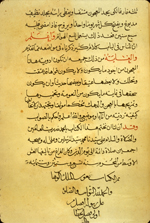Catalogue: Pharmaceutics
A distinct type of pharmaceutical composition was that devoted solely to poisons (including animal and insect bites) and their antidotes. In this category, the National Library of Medicine has in its collections an important treatise composed in the 13th century by ‘Alī ibn ‘Abd al-‘Azīm al-Anṣārī that deserves further study. In addition to this unique treatise, NLM has two anonymous tracts concerned with theriac - a universal antidtoe for poison. Moreover, a treatise by Najīb al-Dīn al-Samarqandī concerned with poisons was catalogued earlier with the medical encyclopaedias (MS A 60, item 2), while another by Ibn al-Kattānī was catalogued amongst the therapeutic treatises (MS A 91, item 1).
-
 Dhikr al-tiryāq al-fārūq (MS A 64)
Dhikr al-tiryāq al-fārūq (MS A 64) - (Memoir on Antidotes for Poisons)
- ذكر الترياق الفاروق
- by ‘Alī ibn ‘Abd al-‘Azīm al-Anṣārī (fl. 1268-70/667-9)
- على ابن عبد العظيم الانصارى
NLM has an important unique copy of ‘Alī ibn ‘Abd al-‘Azīm al-Anṣārī's extensive treatise on poisons and their antidotes. It is evident from the treatise that the author lived in Syria and was familiar with the plants and plant names of Syria and nearby regions.
He is probably the same as the author of a different treatise on antidotes (titled Jami‘ al-iftiraq wa-al-itifaq li- san‘at al-tiryāq) which was composed in 1268 by ‘Alī ibn ‘Abd al-‘Azim al-Ansari al-mutatabbib (the medical practitioner) and is preserved today in a single copy in Princeton University Library (Garrett MS 566H; see Philip K. Hitti, Descriptive Catalog of the Garrett Collection of Arabic Manuscripts in the Princeton University Library (Princeton Oriental Texts, 5). Princeton: Princeton University Press, 1938, entry no. 1104).
The treatise now at NLM, which is arranged in 35 chapters (babs), includes extensive quotations from other treatises on plants and on antidotes, especially those by al-Tamīmī and Ibn al-Suri. The latter is known to have prepared an illustrated herbal with figures drawn from plants he observed on his travels. The writings on antidotes by al-Tamīmī and all the writings of Ibn al-Suri are lost today, and this treatise by al-Anṣārī may be the only source of information regarding them. Other authorities cited include a large number of Greek writers, but especially Galen, as well as Arabic sources such as Abū Hanifah, Ibn Samajun, Yahya al-Nahwi, Ibn Sīnā Avicenna, Ḥunayn ibn Isḥāq, Zahrawi (Abulcasis), Yuhanna ibn Sarabiyun, Ibn Jumay‘, Ibn al-Bayṭār, Sabur ibn Sahl, Ibn Tilmīdh, al-Rāzī, Ibn Juljul, al-Ghafiq, and Ibn Wāfid.
The manuscript also provides us with the information that the composition this book was completed during the middle ten days of the month of Muharram 669 (= 28 August to 8 September 1270).
No other copies are recorded.
Dhikr al-tiryāq al-fārūq (MS A 64)
Illustrations
A unique and important copy of Dhikr al-tiryāq al-fārūq (Memoir on Antidotes for Poisons) by ‘Alī ibn ‘Abd al-‘Azīm al-Anṣārī (fl. 1268-70/667-9). According to this colophon, lines 11-14, the compositon of this book was completed during the middle ten days of the month of Muharram 669 (= 28 August to 8 September 1270). The copy itself is undated and unsigned; the appearance of the paper, script and ink suggests a dating of the early 17th century.
Physical Description
Arabic. 315 leaves (fols. 1b-315a). Dimensions 32.5 x 18.5 (text area 21.5 x 10.2) cm; 21 lines per page. The title is given near beginning of text (fol. 1b line 11). Sommer (Schullian/Sommer, Cat. of incun. & MSS, p. 318) gave the title as: Sharḥ al-tiryāq al-fārūq, given on a paper bag in which the unbound manuscript was kept; the text, however, is not a sharḥ (commentary). The author's name is given (fol. 1b line 7) as: ‘Abd al-‘Azīm al-Anṣārī.
The copy is undated and unsigned. The appearance of the paper, script, and ink, suggests a dating of the early 17th cent. According to the colophon (fol. 315a lines 12-14) the writing of this book was completed (al-faragh min ta'lifiha) during the middle ten days (al-‘ashr al-awsat) of the month of Muharram 669 (= 28 August to 8 September 1270).
The text is written in an elegant large naskh script using dense black ink with headings in red or in large black script. There are catchwords.
On fols. 1b-2a, spaces of up to half a line have been left blank, apparently intended to be filled in later with script using colored ink. One of these lacunas could account for the missing first part of the author's name.
There are two small illustrations of pan-balances found on fols. 46b and 313a, and there are tables on fols. 19b, 298a, 300b and 301b.
There are some marginal corrections by the scribe and occasional textual corrections in several later hands.
The beige paper is highly glossed, with only laid lines visible. The edges have been trimmed from their original size. Some leaves are repaired along the edges. The first eight folios are soiled through thumbing, and there is slight foxing and, on the last few folios, some water damage to the bottom of the leaves.
The volume consists of 315 leaves. Fol. 1a is blank except for a penciled title (sharh-i tiryaq), an English title, and an older Persian title: Risalah-i tibb (Treatise on medicine).
Binding
The volume is bound in a red leather modern library binding with envelope flap. On fol. 315b there are traces of an envelope flap from an earlier binding. There are modern pastedowns and endpapers.
Provenance
The volume was in the collection of the Army Medical Library by 1946; provenance unknown.
References
Schullian/Sommer, Cat. of incun. & MSS., entry A 64, p. 318.
NLM Microfilm Reel: FILM 48-125 no. 1











